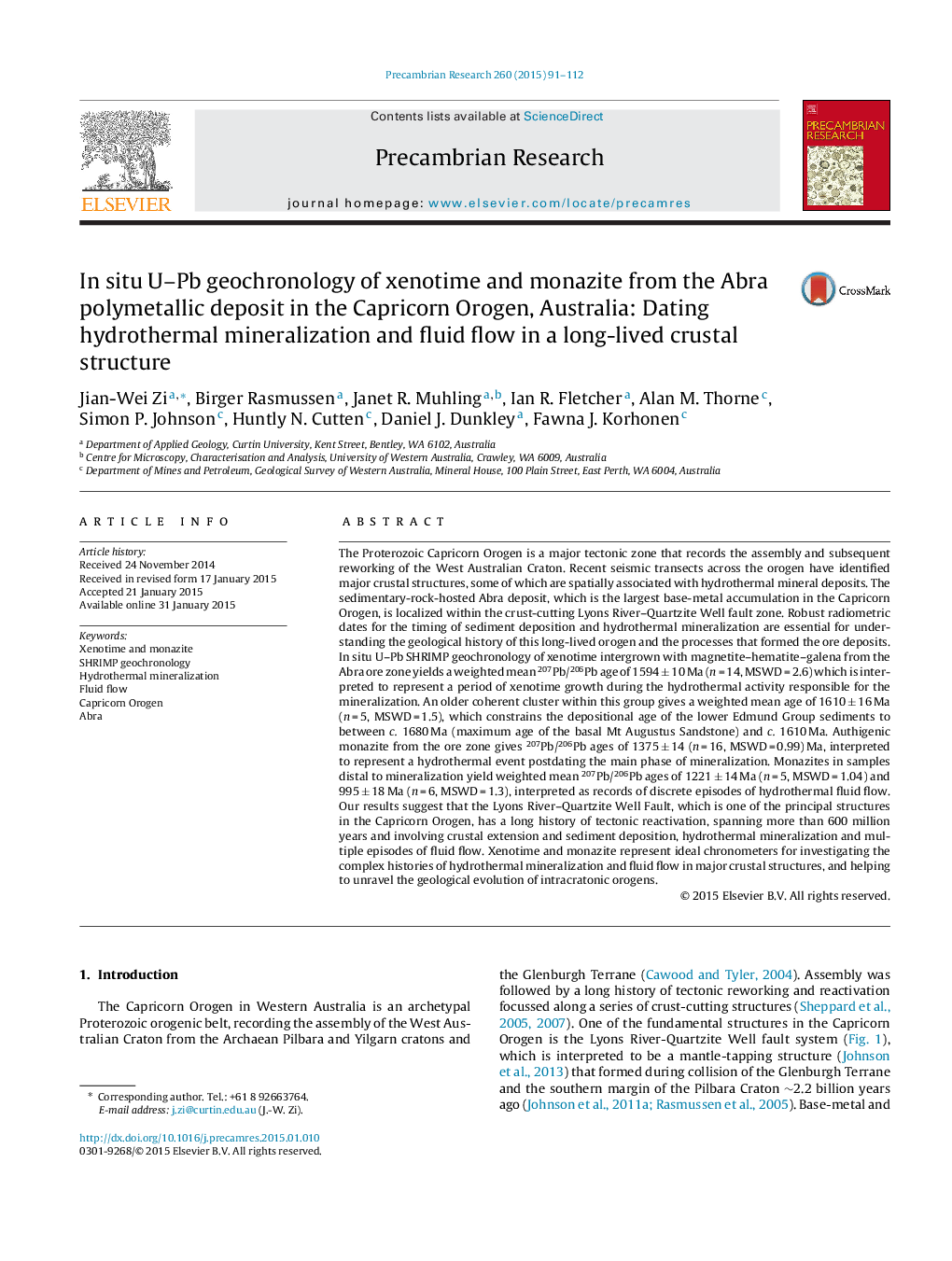| کد مقاله | کد نشریه | سال انتشار | مقاله انگلیسی | نسخه تمام متن |
|---|---|---|---|---|
| 6442259 | 1639615 | 2015 | 22 صفحه PDF | دانلود رایگان |
عنوان انگلیسی مقاله ISI
In situ U-Pb geochronology of xenotime and monazite from the Abra polymetallic deposit in the Capricorn Orogen, Australia: Dating hydrothermal mineralization and fluid flow in a long-lived crustal structure
دانلود مقاله + سفارش ترجمه
دانلود مقاله ISI انگلیسی
رایگان برای ایرانیان
کلمات کلیدی
موضوعات مرتبط
مهندسی و علوم پایه
علوم زمین و سیارات
ژئوشیمی و پترولوژی
پیش نمایش صفحه اول مقاله

چکیده انگلیسی
The Proterozoic Capricorn Orogen is a major tectonic zone that records the assembly and subsequent reworking of the West Australian Craton. Recent seismic transects across the orogen have identified major crustal structures, some of which are spatially associated with hydrothermal mineral deposits. The sedimentary-rock-hosted Abra deposit, which is the largest base-metal accumulation in the Capricorn Orogen, is localized within the crust-cutting Lyons River-Quartzite Well fault zone. Robust radiometric dates for the timing of sediment deposition and hydrothermal mineralization are essential for understanding the geological history of this long-lived orogen and the processes that formed the ore deposits. In situ U-Pb SHRIMP geochronology of xenotime intergrown with magnetite-hematite-galena from the Abra ore zone yields a weighted mean 207Pb/206Pb age of 1594 ± 10 Ma (n = 14, MSWD = 2.6) which is interpreted to represent a period of xenotime growth during the hydrothermal activity responsible for the mineralization. An older coherent cluster within this group gives a weighted mean age of 1610 ± 16 Ma (n = 5, MSWD = 1.5), which constrains the depositional age of the lower Edmund Group sediments to between c. 1680 Ma (maximum age of the basal Mt Augustus Sandstone) and c. 1610 Ma. Authigenic monazite from the ore zone gives 207Pb/206Pb ages of 1375 ± 14 (n = 16, MSWD = 0.99) Ma, interpreted to represent a hydrothermal event postdating the main phase of mineralization. Monazites in samples distal to mineralization yield weighted mean 207Pb/206Pb ages of 1221 ± 14 Ma (n = 5, MSWD = 1.04) and 995 ± 18 Ma (n = 6, MSWD = 1.3), interpreted as records of discrete episodes of hydrothermal fluid flow. Our results suggest that the Lyons River-Quartzite Well Fault, which is one of the principal structures in the Capricorn Orogen, has a long history of tectonic reactivation, spanning more than 600 million years and involving crustal extension and sediment deposition, hydrothermal mineralization and multiple episodes of fluid flow. Xenotime and monazite represent ideal chronometers for investigating the complex histories of hydrothermal mineralization and fluid flow in major crustal structures, and helping to unravel the geological evolution of intracratonic orogens.
ناشر
Database: Elsevier - ScienceDirect (ساینس دایرکت)
Journal: Precambrian Research - Volume 260, May 2015, Pages 91-112
Journal: Precambrian Research - Volume 260, May 2015, Pages 91-112
نویسندگان
Jian-Wei Zi, Birger Rasmussen, Janet R. Muhling, Ian R. Fletcher, Alan M. Thorne, Simon P. Johnson, Huntly N. Cutten, Daniel J. Dunkley, Fawna J. Korhonen,